
The Child in You
The Breakthrough Method for Bringing Out Your Authentic Self
- اطلاعات
- نقد و بررسی
- دیدگاه کاربران
نقد و بررسی

November 1, 2020
This insightful exhortation for self-acceptance comes from experienced psychotherapist Stahl. Originally published in Germany, it was the number one bestselling non-fiction title for three consecutive years, and it's easy to understand why. Very short chapters--a few paragraphs to a few pages--revisit childhood developmental stages, reminding readers how childlike emotional responses and rationalizations differ from adult reactions, reflexes steeped in years of social conditioning. Stahl revisits theories regarding our inner child, identifying two influences: a shadow child, encompassing grief, fear, hopelessness, and anger; and a sunshine child, reflecting spontaneity, curiosity, vitality, and drive. Using direct language, Stahl describes scenarios, analyzes what's going on from a psychological standpoint, suggests alternative behaviors and outcomes, and provides exercises to help readers get in touch with their inner selves. These exercises model conversations and incorporate concrete actions that emphasize self-protection. The current pandemic lockdown restrictions have given many people time to reflect on themselves and their personal relationships. This is a helpful guide that offers lots to think about, combined with practical advice.
COPYRIGHT(2020) Booklist, ALL RIGHTS RESERVED.

January 4, 2021
German clinical psychologist Stahl (Yes, No, Maybe) uses the metaphor of the inner child to help readers work through formative childhood experiences in this compassionate work. She proposes that the inner child is an unconscious part of one’s personality defined in childhood, which is split between the “shadow child” (feelings of helplessness that inspire defense mechanisms and self-protection) and the “sun child,” (feelings of love and protection that inspire self-esteem) and is often in conflict with one’s “inner adult,” or “our rational and reasonable mind.” As people try to secure the four basic psychological needs of connection, autonomy, pleasure, and avoidance of displeasure, Stahl posits, the shadow child’s negative beliefs lead to self-protection strategies that result in perfectionism, overadjustment, conflict avoidance, and other negative habits. To heal the shadow child, Stahl recommends reinforcing one’s sun child and inner adult through self-reflection, rational analysis, and speaking to oneself as the shadow child. Stahl argues that one is “100 percent responsible” for one’s own happiness, and that happiness must be attained through dismantling negative self-defense mechanisms and cultivating one’s ability to live in the moment. Readers of psychology or self-help will be enlightened by this straightforward, intuitive, and sensitive investigation.




دیدگاه کاربران